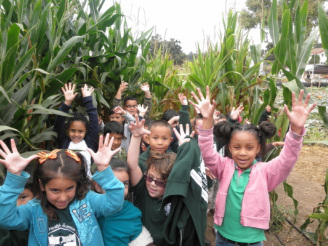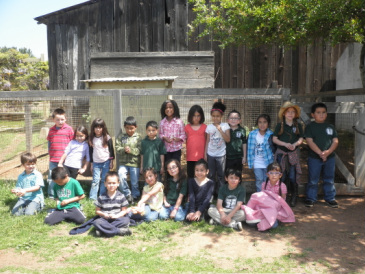Introduction
“He hit me!”......“She took my paper!”......“I’m telling!”.......“Ms. Olson!”
A scenario in the typical day of every kindergarten teacher. Even though five year olds are learning how to communicate with their peers and tend to tattle instead of solving their conflicts independently I truly believe that kindergartners are the best! I couldn’t imagine teaching another age group. Each day I arrive at school happy and ready for what we will learn and explore together. Everyday is magical! I am constantly in awe of my students, it is incredible to watch them grow. Most kindergartners begin the school year knowing the names of some letters and when they leave me, they are reading. It is hard, as a fluent reader to look back and imagine the world before I joined the world of literacy. I get to experience that day with my students every year, when they have an “ah-ha” moment and realize they can read. I love what I do and I consider it a privilege not a job.
A scenario in the typical day of every kindergarten teacher. Even though five year olds are learning how to communicate with their peers and tend to tattle instead of solving their conflicts independently I truly believe that kindergartners are the best! I couldn’t imagine teaching another age group. Each day I arrive at school happy and ready for what we will learn and explore together. Everyday is magical! I am constantly in awe of my students, it is incredible to watch them grow. Most kindergartners begin the school year knowing the names of some letters and when they leave me, they are reading. It is hard, as a fluent reader to look back and imagine the world before I joined the world of literacy. I get to experience that day with my students every year, when they have an “ah-ha” moment and realize they can read. I love what I do and I consider it a privilege not a job.
I know that conflicts occur at all ages and in all grades, but it seems like kindergartners tattle much more frequently than other grades. They are transitioning from playing next to someone to playing with someone, many have never been to school nor been around other kids their own age, and they are not quite able to express themselves in a clear and concise manner. Not to mention that they are only five years old and have not learned the appropriate social skills needed to communicate. So naturally problems tend to happen regularly. I have wondered that there must be a way for kids at this unique age to learn to resolve problems independently.
I want to create a community of problem solvers. I hope to give my student the skills to take conflicts and resolve them peacefully. It is important in today’s world that they learn to use their words and have a dialogue. Violence (verbal or physical) is not the answer to any conflict. I hope that they become leaders. I want to empower my students by building their self-confidence and give them the tools to take charge of the difficult situations they may find themselves in.
Just imagine all the academic learning that can happen in a single day if there wasn’t the distraction of constant disagreements. Now I’m not saying that I want to have a utopian society where problems disappear altogether because that is not realistic. However, it would be amazing to have a classroom where students interacted peacefully and when a conflict did arise they were capable of handling it without immediate teacher intervention. I see that it’s possible. I believe that even children as young as kindergartners are able to resolve conflicts independently, and by helping them to do so, they are learning skills that will benefit them the rest of their lives.
I also believe that giving them the power to resolve conflicts will give them more control of their learning environment. According to Richmond and McCroskey (1992) students need to learn more than just content. They have to learn how to learn, how to reason, and how to test assumptions. It is also important for students “to learn to behave in a socially responsible manner so that they can cooperate and collaborate, treat others with respect, listen and learn from others, and yet take responsibility for their own actions.”
What has started out as a simple question with a not so simple answer has increased to a school-wide wondering. As a new school, we are in a perfect position to implement a problem-solving program. We have adopted Caring School Community (CSC), a program that focuses on building respectful and supportive relationships between students, teachers, and parents. I am looking forward to using ideas from CSC in my own action research. I have also been researching many different conflict resolution programs to find what works well, how lessons are implemented, and areas of focus in various programs. Some of the features that I have found valuable and will use during my action research will be from: Primary Peacemakers, Second Step, Project WIN, TRIBES, What Do You Stand For?, Stick Up For Yourself!, The Community Board Program - Conflict Resolution Resources for Schools and Youth, Love and Logic, and Wise Words. Through my research I hope to find/create/adapt a conflict resolution design that will be aligned with and supports our charter and that best supports current curriculum, our teachers, and most importantly our students. I am eager to begin this journey towards creating a peaceful classroom.
Now the question becomes: How do I do this? I see the vision, the end product, the community of students working together. I want to figure out the process. How can a child realistically use conflict resolution skills as part of their natural daily language? What are ways to discourage tattling? How do I build the confidence in my students to take charge of situations? Are five and six year olds developmentally ready for this? Do they understand the difference between tattling and telling the teacher? Will students remember to use their words between friends to solve disputes? I want to create a peaceful learning environment at my school. So what better way to do that than by diving in to the research question: How do I design and implement a conflict resolution program that creates a community of problem solvers?
I want to create a community of problem solvers. I hope to give my student the skills to take conflicts and resolve them peacefully. It is important in today’s world that they learn to use their words and have a dialogue. Violence (verbal or physical) is not the answer to any conflict. I hope that they become leaders. I want to empower my students by building their self-confidence and give them the tools to take charge of the difficult situations they may find themselves in.
Just imagine all the academic learning that can happen in a single day if there wasn’t the distraction of constant disagreements. Now I’m not saying that I want to have a utopian society where problems disappear altogether because that is not realistic. However, it would be amazing to have a classroom where students interacted peacefully and when a conflict did arise they were capable of handling it without immediate teacher intervention. I see that it’s possible. I believe that even children as young as kindergartners are able to resolve conflicts independently, and by helping them to do so, they are learning skills that will benefit them the rest of their lives.
I also believe that giving them the power to resolve conflicts will give them more control of their learning environment. According to Richmond and McCroskey (1992) students need to learn more than just content. They have to learn how to learn, how to reason, and how to test assumptions. It is also important for students “to learn to behave in a socially responsible manner so that they can cooperate and collaborate, treat others with respect, listen and learn from others, and yet take responsibility for their own actions.”
What has started out as a simple question with a not so simple answer has increased to a school-wide wondering. As a new school, we are in a perfect position to implement a problem-solving program. We have adopted Caring School Community (CSC), a program that focuses on building respectful and supportive relationships between students, teachers, and parents. I am looking forward to using ideas from CSC in my own action research. I have also been researching many different conflict resolution programs to find what works well, how lessons are implemented, and areas of focus in various programs. Some of the features that I have found valuable and will use during my action research will be from: Primary Peacemakers, Second Step, Project WIN, TRIBES, What Do You Stand For?, Stick Up For Yourself!, The Community Board Program - Conflict Resolution Resources for Schools and Youth, Love and Logic, and Wise Words. Through my research I hope to find/create/adapt a conflict resolution design that will be aligned with and supports our charter and that best supports current curriculum, our teachers, and most importantly our students. I am eager to begin this journey towards creating a peaceful classroom.
Now the question becomes: How do I do this? I see the vision, the end product, the community of students working together. I want to figure out the process. How can a child realistically use conflict resolution skills as part of their natural daily language? What are ways to discourage tattling? How do I build the confidence in my students to take charge of situations? Are five and six year olds developmentally ready for this? Do they understand the difference between tattling and telling the teacher? Will students remember to use their words between friends to solve disputes? I want to create a peaceful learning environment at my school. So what better way to do that than by diving in to the research question: How do I design and implement a conflict resolution program that creates a community of problem solvers?


